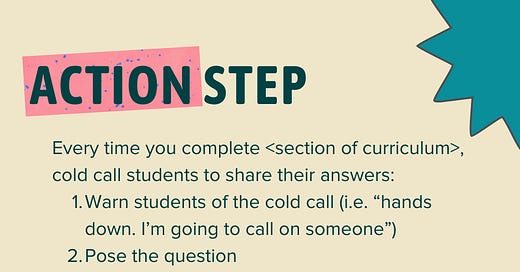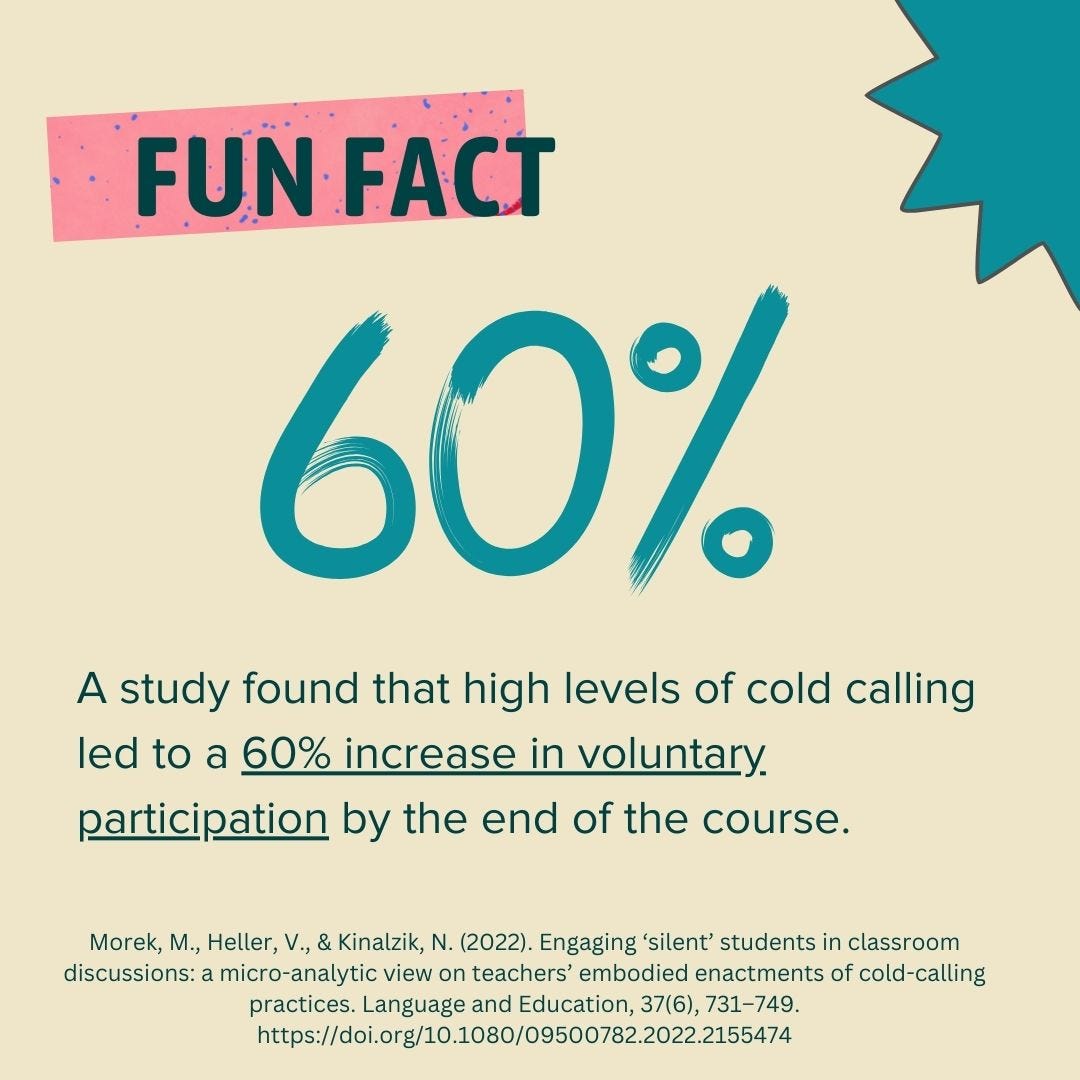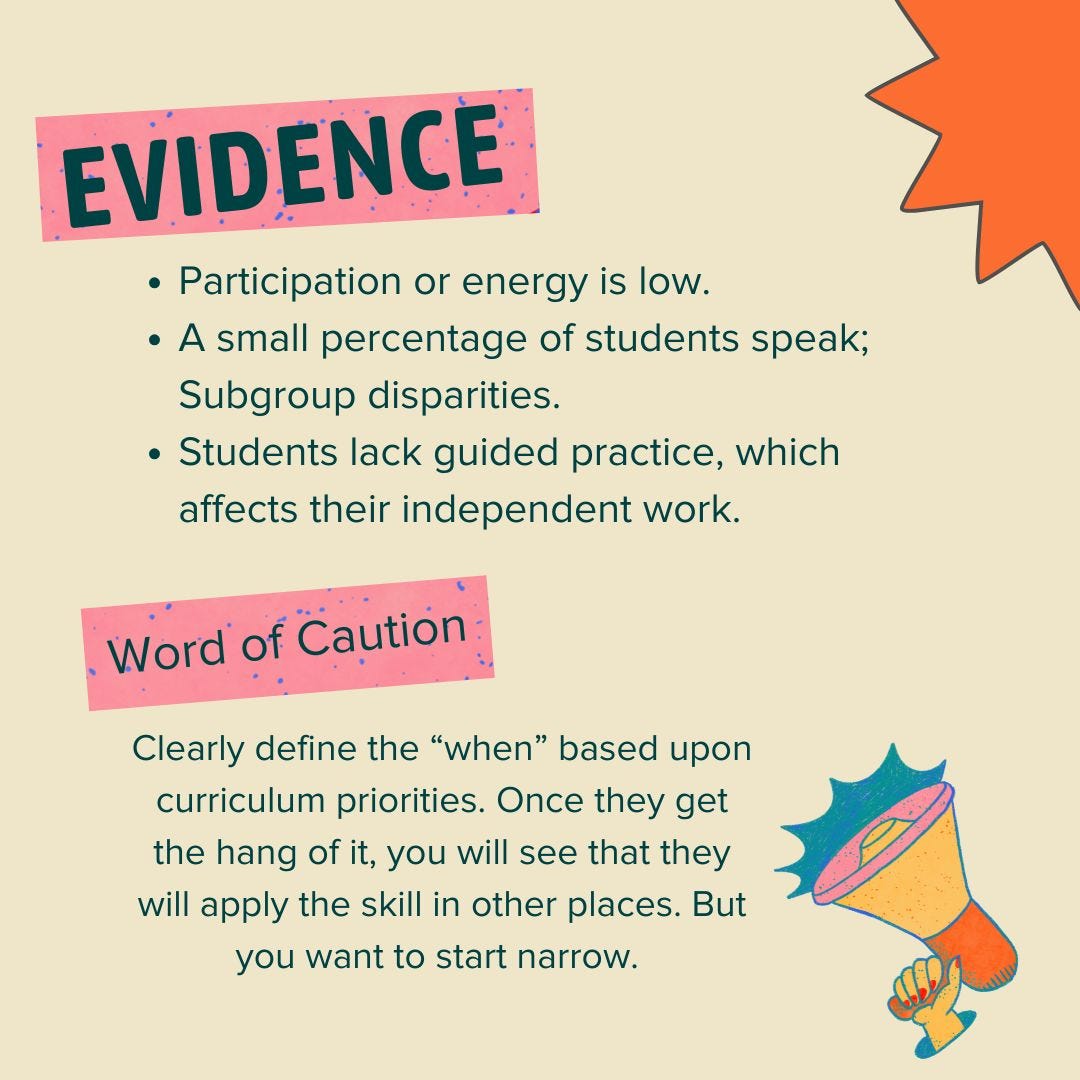Action Step of the Week: Cold Call
High levels of cold calling led to a 60% increase in voluntary participation
Action Step of the Week
Every time you complete <section of curriculum>, cold call students to share their answers:
Warn students of the cold call (i.e. “Hands down. I’m going to call on someone”)
Pose the question
Call on a student you need to elicit data from*
(If unable to answer - practice ‘no opt-out’)
* Using a randomizing strategy, such as popsicle sticks, a spinny wheel, or numbers on the tables is optional.
Why?
Cold calling is an effective classroom strategy for several reasons:
1. It promotes inclusive participation, which increases class participation. Studies show that student participation is over 90% in high-cold-calling classrooms compared to just over 50% in low-cold-calling sections.
2. It provides real-time formative assessment. Cold calling allows teachers to check for understanding systematically and effectively, enabling them to gauge any student's level of mastery at any time. This immediate feedback helps teachers identify misconceptions and adjust their instruction accordingly.
3. It keeps the class engaged and moving.
4. It reduces achievement gaps. When teachers allow only hand-raising, they may inadvertently widen achievement gaps as engaged students get more practice.
5. It improves communication skills. Regular cold-calling exposure helps students become more comfortable with class discussions. A study found that high levels of cold calling led to a 60% increase in voluntary participation by the end of the course.
6. It promotes equity. Cold calling has been shown to create a more equitable environment, particularly for female students, leading to equal participation rates between males and females.
When implemented correctly, cold calling can create a positive classroom atmosphere where students feel safe taking risks and participating actively.
The key is to use it as an invitational rather than a punitive strategy, focusing on creating a supportive environment where all students' contributions are valued.
Potential Evidence
Participation or energy is low.
A small percentage of students speak; Subgroup disparities.
Students lack guided practice, which affects their independent work.
Questions to Ask Yourself
What percentage of students are participating?
What subgroups do we hear from more?
What part of the physical room do I notice more voices coming from?
What data are we missing? Who are we unclear about their mastery?
How would I describe the energy in the room?
What are the gaps in the independent practice? Who is struggling? What is the connection to participation to guided practice?
Glossary of Terms
Cold Call: A teaching strategy where the teacher calls on students to answer questions or participate in discussions without them volunteering first.
No-Opt-Out: A follow-up strategy ensuring that a student who struggles with or avoids answering a cold call question is guided to eventually provide a correct response. Example: If a student initially says, "I don’t know," the teacher prompts them with clues or returns to them later.
Randomization: The practice of calling on students in an unpredictable order to ensure equity and maintain engagement. Example: Using a name jar, spinner, or app to select students at random.
Targeted Cold Call: A deliberate choice of a specific student for a cold call based on their learning needs, progress, or prior behavior.
Coaching Conversation Template
How to use it:
Find any bracketed text.
Fill this in BEFORE you meet with the teacher. You will look silly and I would feel sad. Only use ONE of the evidence examples.
Be you! You can do it. The best coaches are planned coaches.
Praise/Follow Up on Previous Action Steps
I appreciate the opportunity to sit down with you to discuss my observation.
First, I want to follow up on <previous action step or feedback>. Tell me more about how this is going for you. What impact has this had on you and your students?
Today, I saw <positive evidence of specific teacher action>.
What impact does this move have on you and your students?
Evidence
I want to hone in on some evidence I collected when I was in your classroom.
<participation is low> (i.e. You had 23 kids in your class today. About how many do you think participated during the guided practice? I counted 7. Let’s see how we can increase that number by practicing cold calling. How does that sound?)
<subgroup disparities> (i.e. I collected some data today that I wanted to share with you. You had 23 kids in the class. Seven of them share during guided practice. Of those seven, six were boys. What does that bring up for you?)
<gaps in independent practice> (i.e. Today, I noticed an interesting connection. About 50% of the students had a hard time getting started with the independent practice. When I trace it back, these are the same kids who did not participate in your questioning during guided practice. So I want to give you a strategy to be able to address that. How does that sound?)
Action Step
Great, so here is your action step: Every time you complete <section of curriculum>, cold call students to share their answers:
Warn students of the cold call (i.e. “Hands down. I’m going to call on someone”)
Pose the question
Call on a student you need to elicit data from*
I bet you wonder what you do if a student refuses to answer. We are going to be practicing that so hold on to it. But first, tell me: What impact will this have on you and your classroom?
Go ahead and write down the action step.
Plan/Practice
Let me show you what this looks like with the lesson that I observed.
MODEL
(Use the curriculum resource to plan this model carefully)
We are going to be focusing on the <section of the curriculum>. I have these questions. Not all questions are good for cold calling. It needs to be narrow enough that it can be answered by a single student with not a lot of think time. Let’s take <complex question from curriculum>. That’s too big to do as a cold call. You can break it down into a cold call by asking about <single step or single example>.
Now that I have my question, I am going to show you the cold call.
“Ok, here’s the question. Now, keep your hands down because I am going to randomly call on you so be ready. <Question from curriculum>. What’s first?”
What did you see in my model that is present in the action step?
PLAN
Let’s practice this for tomorrow. Find the <section from the curriculum> and let’s identify the questions to use. Tell me what you are thinking. What makes this an effective question for a cold call?
PRACTICE
Now, let’s practice execution. I’ll play the students. Go ahead and ask me the question.
Look for:
Body language and tone
Question is appropriate for a cold call
Wait time
Student’s name after the question
Warning is appropriate and authentic
Ok, what happens if a student refuses to answer? What is your instinct? We can practice a strategy called “no opt-out.” In this move, you call on another student to answer and then go back to the original student to repeat it.
Look for:
Responds in a supportive or neutral tone
Returns to student
Repeats the question
Closing/Follow Up
Thanks for playing along. I know practice can be awkward, but it is a great way to ensure we can work out all the kinks.
Let’s review the action step.
To follow up, I would love to see this in action and so we can work out all of the kinks. I look forward to seeing you in action <date>.







